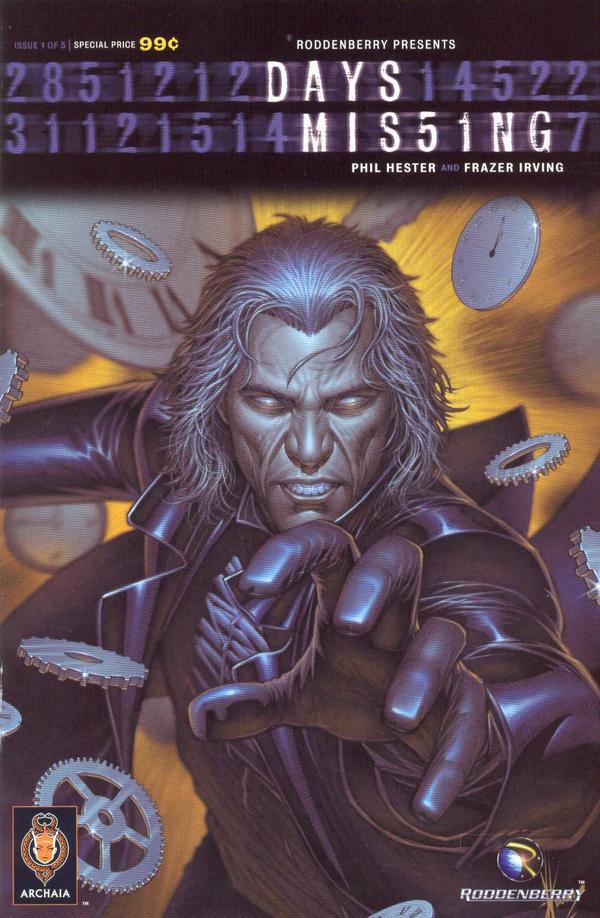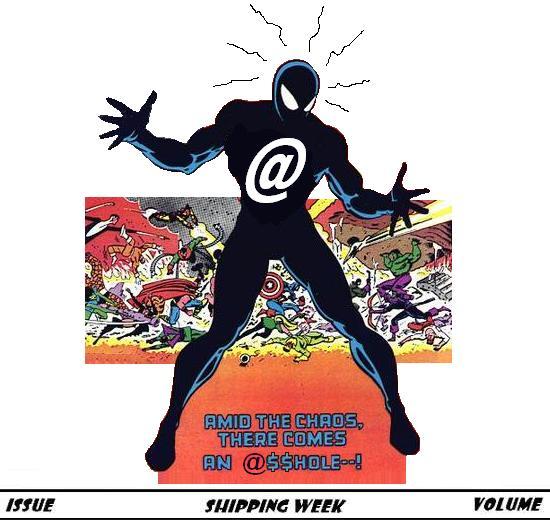
| #21 | 9/30/09 | #8 |
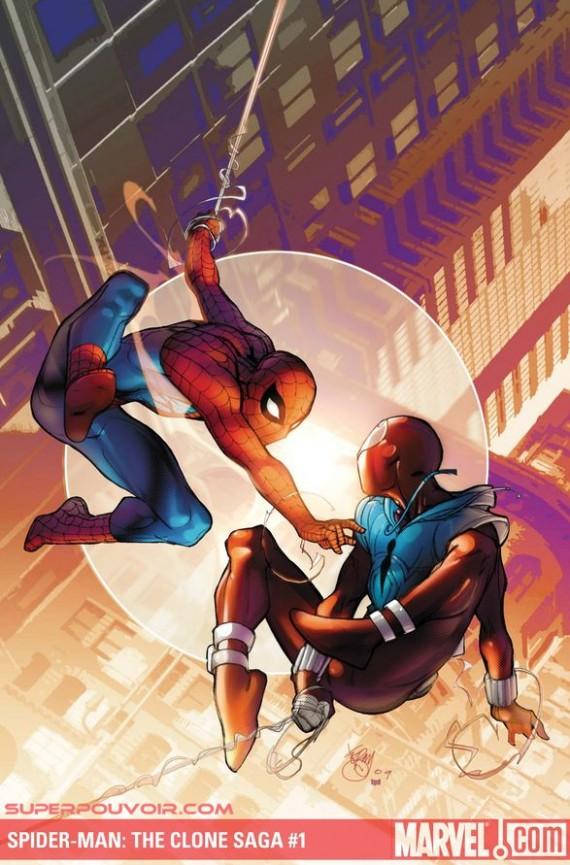
SPIDER-MAN: THE CLONE SAGA #1
Writers: Tom DeFalco & Howard Mackie Penciler: Todd Nauck Inker: Victor Olazaba Colorist: Javier Tartaglia Publisher: Marvel Comics Reviewer: Matt Adler
It has now been 13 years since the original “Clone Saga” ended, bringing to a close a tumultuous period in Spider-Man history. As the recap page explains, this new series is an attempt to take those 3 years worth of stories and condense them into 6 issues. Why? Because, despite the controversy it caused, and despite many who condemn it, it was one of the best-selling Spider-Man storylines of all time, and there are also many who feel there were a lot of compelling and valuable elements to it that were unfortunately discarded in the wake of the controversy.The controversy was primarily due to two factors. The first is that in 1995, the Clone Saga attempted to tell its readers that the Peter Parker they’d been reading about for the past 20 years was not really Peter Parker. That he was, in fact, a clone created by a villain called the Jackal, and the character thought to be his clone (who had been gone those 20 years) was in fact the real Peter Parker. As you can imagine, this did not go over well.
This was a precursor to the recent “One More Day” storyline, which similarly retconned Peter Parker’s history. Like “One More Day”, several of the writers and editors involved with the Clone Saga have explained in interviews that, even going back to when the decision was first made under former Marvel editor-in-chief Jim Shooter, they had always felt it was a bad idea to marry Peter Parker off. So to them, the Clone Saga was the first in a long line of attempts to get back to a single Peter Parker. It should be noted that this view is not unanimous; the editor-in-chief at the time of the Clone Saga (and one of its key writers), Tom DeFalco, strongly denies that this was the original intent of the Clone Saga, and has even said that his plan all along was to restore Peter Parker as the one true Spider-Man, after putting him through the identity crisis for the purposes of drama.
Whatever the case, all parties agree on the second factor of controversy: that the Clone Saga became dragged out due to corporate suits in the sales and marketing departments exerting power over editorial, and forcing them to extend the storylines because they were selling so well. In short, the Clone Saga became a victim of its own success, and a story that was supposed to last a few months wound up lasting 3 years, taking so many twists and turns, and adding in so many superfluous elements, that according to its writers, it lost sight of its goals and became a complete mess, eventually ending in a way that satisfied virtually no one.
The details of this are glossed over on the recap page, written by Tom DeFalco. He does acknowledge the controversy and the unnecessary extensions, and explains this project’s goal, which is to retell the Clone Saga as they originally intended and hopefully give the readers what they were denied with the original: a satisfying, complete story. Surprisingly, the recap page also covers several of the major stories that directly preceded the Clone Saga, including the death of Harry Osborn, Maximum Carnage, and the return of Peter Parker’s parents. It’s possible this is done simply to set the context for the Clone Saga, and show how much of a blow it would be to an already frazzled Peter Parker, but you have to wonder whether any of these stories are going to play into what they had originally intended for the Clone Saga.
Reading through this first issue gives you a pretty solid idea of how they are going to compress 3 years worth of stories into 6 issues. The issue opens with Aunt May having some sort of health crisis that involves chest pains, causing her to collapse into unconsciousness, and be rushed to the hospital where she is placed on a ventilator. We are firmly told it is not a heart attack or any of the other usual suspects, but rather some mystery ailment. Right away, this differs from the original, in which her illness was indeed a heart attack due to her age and infirmity, no mystery involved.
The issue ends with Peter and his clone Ben Reilly surviving an attack from the mystery man Kaine. Here, Kaine is shown not to be a lone wolf with his own agenda, but working for a shadowy mastermind, who declares “No one knows his Spider-Men better than I.” Personally, I’m not crazy about this; I really prefer Kaine as a rogue driven solely by his own inner demons, rather than anybody’s stooge. As for the mastermind, the obvious candidate would be the Jackal, and it certainly could be him, but there are some details that make me question it. First, although we only see him in silhouette, his cuffs make it appear that he’s wearing a business suit; the Jackal was known to wear either green spandex, or a leather overcoat, and nothing else. Second, the Jackal had some distinctive features; sharp claws, pointed ears, and on occasion, tufts of fur sprouting from his head. None of those are in evidence here. A few other details just seem a little off for the Jackal; the glass of expensive liquor he’s poured for himself, the huge “evil mastermind” chair he’s reclining in, the folders strewn about his desk; it’s nothing concrete, but it just doesn’t quite feel like him.
So who else could it be? Some other possible candidates would be Harry Osborn (he’s mentioned in the recap, and it was considered using him as the Clone Saga mastermind in years past), Norman Osborn (who ultimately did turn out to be the mastermind), the Chameleon (again mentioned in the recap), or even Doctor Octopus (who also played a significant role in the original Saga). But we’ll have to wait and see.
Because many of the storyline details have been altered or omitted, it’s difficult to make a direct comparison to the original Clone Saga, but in broad terms, this one issue probably compresses about 8 months of the original storyline (from Aunt May falling ill, to the first hint of a “mastermind” behind the story), or more than 32 issues. Not bad for a single issue, and it’s a tribute to DeFalco and Mackie’s storytelling skills that they can pull this off.
But there are downsides to this approach. The weakest part of the comic is the reunion between Peter Parker and Ben Reilly. In the original Saga, when Peter first came face to face with Ben after believing him dead for 5 years (in Marvel time; in our time, as mentioned, it was more like 20), it was a complete shock, and a trauma in and of itself, on top of everything else that had been happening to Peter. It took Peter months, in our time, to come to terms with his clone and not see him as a potential enemy. Now, whereas most of the elements of the Clone Saga took too long to play out, the relationship between Peter and Ben is one thing that benefitted from those extended periods of time; it made the relationship more real, more authentic. If you met someone who threatened your very sense of self just by his existence, no matter how nice a guy he was, it would take you a while to accept him.
DeFalco and Mackie seem to acknowledge this limitation, given that they have only 6 issues, and even make reference to it in a line that Kaine thinks to himself, when he witnesses the two Spider-Men working together to prevent a disaster: “They couldn’t possibly have put aside their differences so quickly. Not after all these years. There should be more distrust. More paranoia. Their annoying sense of responsibility must have kicked in and forced them to work together—to prevent any collateral damage.” It’s a decent effort to explain, in story terms, why they had to rush through their “courtship”, but it’s still awkward. But with the news that the original Clone Saga will be collected, it will be a good opportunity for newer readers to pick it up, and compare how the relationship was handled in those stories.
There also appears to be a concerted effort to tie all elements of the story together more tightly than they were in the original Saga; everything from the suggestion that Aunt May’s illness was caused by sinister forces, to Kaine working for a shadowy mastermind, to the revelation that the mastermind launched his attack on the Spider-Men in order to make them bond with each other more quickly. There’s something to be said for this approach in terms of story logic; one of the criticisms of the original Saga is that it had all these random elements popping up that led to the story feeling like it was all over the place. But on the other hand, I kind of liked the feeling that trouble could come at Spider-Man from any direction, and that just because he’d beaten one villain didn’t mean his troubles were over. That was just the nature of his life; bad things happened to him. Nothing was conspiring against him except fate.
It’s been a while since I’ve read a comic by Howard Mackie, and I read Tom DeFalco’s writing every month in the pages of SPIDER-GIRL, so it’s possible I’m just recognizing more of Tom here, but overall this feels primarily like Tom’s writing, especially in the humor. Tom even appears to poke fun at his own penchant for having the characters explain things for the readers, when Ben snipes at Peter for announcing what we can see on the page, and Peter replies “Swell! You just sit back and critique my exposition. I have more important things to do.” This book has a much lighter tone than the original Saga; back then, Peter was very much in a brooding, angry, on-the-edge phase, and there was a lot less joking around. So a change in art style makes sense for the change in tone, and Todd Nauck’s art fits the bill, as it is noticeably lighter than the intense Bagley and Buscema pages of yesteryear.
Because the entire purpose of this series is to tell the story “the way it was originally intended”, that, more than anything, is the real mystery here; how will it end? Who did they intend to be the real Peter Parker? What will happen to Aunt May and Mary Jane? And if one Spider-Man is the real one, does the other one have to go?
The inception of this series came from Howard Mackie’s original notes, written when they were first planning the story, and just recently rediscovered. Mackie has been significantly more cagey in interviews regarding the question of the Clone Saga being intended to replace Peter Parker, but he has alluded to feeling that the marriage was a problem. So what if DeFalco and Mackie had different “original intentions”? Hopefully (and it’s probably a good bet) the eventual collected edition of this series will include a copy of Mackie’s notes, and commentary from the two of them on how they settled on the conclusion. But who knows; just because this series is being sold as “what they originally intended” doesn’t mean that they can’t make different decisions about the story now.
In most places, Matt Adler goes by the name his mother gave him, but occasionally uses the handle "CylverSaber", based on a character he created for the old DARK FORCES II: JEDI KNIGHT game (one hint of his overweening nerddom). He currently does IT and networking support for the government of Nassau County, NY, but his dream is to write for a living, and is in the process of figuring out how to get publishers to give his stuff a look. In the meantime, he passes the time by writing for AICN, CBR, and a few other places. He has also written for MARVEL SPOTLIGHT magazine.
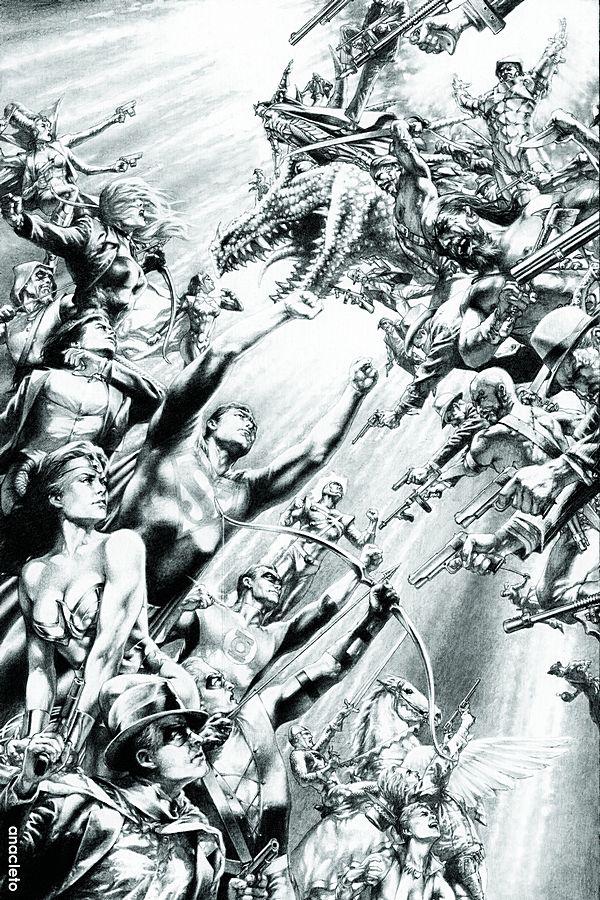
JUSTICE LEAGUE OF AMERICA 80 PAGE GIANT ANNUAL #1
Writer: Rex Ogle, JT Krul, Rich Fogel, Josh Williamson, Chuck Kim, Derek Fridolfs, Amanda McMurry Pencils: Mahmud Asrar, Adrian Syaf. Eric J, Bit, Justin Norman, Jon Buran, Daxiong Publisher: DC Comics Reviewer: Jinxo
Good Lord, after listing out all the writers and artists involved in this sucker I don't know that I have the energy to actually write the review. Wow.So. Giant ass annual. These things can easily go two ways. They can be a huge epic one shot that's a bunch of fun, or they can be a huge epic waste of time--a throwaway where you wonder if it was worth putting out a giant annual to tell.
This one falls somewhere in the middle but more towards the better end of the spectrum. I mean, to their credit DC throws in everything but the kitchen sink. As I've already pointed out, they had a ton of folks working on it. That's partly because the book is broken down into a number of smaller stories, each with its own team working on it. The story itself spans multiple eras, featuring not only a large number of Justice League heroes but also big name heroes and villains from the four corners of the DC Universe.
The starting point for all the action has the League fighting the time traveling villain Epoch who has come to our time to prevent his foe Time Commander from ever being born. In very short order Epoch blasts the twelve Leaguers attacking him into the past, conveniently in sets of two. The book then becomes six short adventures featuring each team while in the present Snapper Carr and his bad guy girlfriend Cheetah try to help Time Commander defeat Epoch and get the JLA back to the here and now.
Technically speaking, the book is a bunch of stories without much real impact. Basically while waiting to be rescued all the League members get involved in some adventure that likely won't disrupt the space time continuum or change anything in a meaningful way. BUT after such a long run of JLA issues that seemed to tread water this at least had the feel of momentum. The writers get in, set up a scenario, have the heroes kick some ass and get out. Quick, simple, amusing action tales. If I have a complaint...it would have been nice if each short story somehow added to the Epoch tale bookending everything; if somehow their adventures actually helped in the defeat of Epoch. Still, it was fun watching the random pairings of Leaguers teaming up with each other AND the DC heroes of the past. It made for some interesting mixes. In particular I liked Zantanna and Black Canary in the 1930s teaming up with The Crimson Avenger and Canary's grandfather Detective Richard Drake. The source of Green Arrow's ethical yet "logical" beliefs about time travel also made me laugh.
Finally I have to point to the book's funniest flaw. Somewhere in organizing all the moving parts of this book, someone must have missed a memo. Or maybe they couldn't decide until the last moment who the twelfth Leaguer in the story would be. All I know is, even though Steel is blown back into the past and shares a swashbuckling adventure with Wonder Woman, he is oddly missing from every shot in the Epoch story. In the splash panel at the start Epoch blows eleven heroes into the past. At the end, eleven heroes pop back from the past to confront him. In my mind I just imagine Steel just sitting around at home (for some reason in costume) when he hears a commotion outside, looks out the window saying, "What the hell is going on out there?" and accidentally gets hit with part of the time blast. Then at the end he's right back in his apartment, confused as hell and thinking he should lay off the booze.
Still, while not a classic for the ages, it's a solid book if you’re just looking for some old school simple comic adventures with a massive cast. Any book that can give me Green Arrow and Firestorm teaming up with the Frankensteinish The Bride against Ra's Al Ghul just for laughs is a good time.
Jinxo is Thom Holbrook, lifelong comic book reader, and the evil genius behind poobala.com. He may appear cute and cuddly but if encountered avoid eye contact and DO NOT attempt to feed.
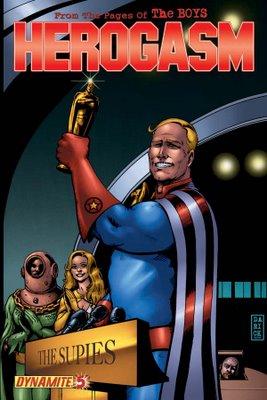
HEROGASM #5
Writer: Ennis Artists: McCrea, Burns Publisher: Dynamite Entertainment Reviewer: Optimous Douche
There’s a little known corporate expression that gets thrown around called the ‘Lizard Brain”. The Lizard Brain is that small part of our gray matter that has remained unchanged since we climbed out of the primordial ooze. It’s the reactionary part of the brain that makes us want to abandon our evolved rational thought and merely guides us to flee, fight or fuck in response to outside stimulus. It’s also the part of the brain that shoots out neurons in rapid fire succession whenever I read THE BOYS or its spinoff sister title HEROGASM. Puerile, base and void of redemption are the common phrases that get bandied about with THE BOYS universe (and a lot of other Ennis’ work for that matter), and on the surface I would have to agree. Scene-by-scene, whether it’s a ruskie downing a dildo or just some good ole man on woman ass play, the separate parts of an Ennis piece do require a strong constitution. However, if you take a moment to truly look at the overarching message what you will find with THE BOYS and HEROGASM is an indictment of the current state of comics and by extension, modern society.The first four issues of HEROGASM, the awards ceremony/exercise in hedonism for the corporate controlled super beings of THE BOYS universe, delivered exactly what we would expect. It faithfully delved into the all the tawdry “what ifs” of the superhero id unleashed on resort hotel. Issue 5, though, is the perfect example of the fact that Ennis is more than a mere peddler of snuff and pornography; every page built tension and deepened the misdeeds of government and corporate entities alike without one fuck scene or splattered head against the wall. Yes, the C-bomb is still dropped with reckless abandon, yes there is one blatant potty joke, but at the same time isn’t that what the world is made of, those that wallow in the mire and those that are able to rise above?
Clearly an indictment of our past presidential administration, Ennis has placed both the President and Vice President of the United States within an epic power struggle without either having any true power. Both men live to serve the interests of their corporate sponsors, while also being subjects of the Machiavellian manipulation of “The Party.” THE BOYS have one simple mission: take out the Vic the Veep who has come to HEROGASM to fly with eagles — actually, make that fuck and do copious amounts of drugs with eagles. Never simply content to take orders, THE BOYS have set out to unravel just who is actually pulling the strings. I would like to say this issue brought them closer to the answer, but really just posed more questions. What was The Homelander going to reveal during his Supe of the Year speech? Will the Secret Service live to see tomorrow after divulging information to THE BOYS? What does Vought America have on the Homelander? Why does Wee Hughie’s ass itch? With only one issue left, I’m suspecting a lot of answers in the next 32 page issue.
Now, I wouldn’t be doing my job if I didn’t point out a moment of this book that is sloppier than a gang bang with a squirter. It appears as though the inkers were struck deaf, dumb and blind during the scene when the hooker tries to seduce the Vought America executive. She’s blonde, no she’s brunette, her dress is green…no…her dress is black. Seriously guys, I won’t say that two inkers need to be in the same room with one another, but at least be sure they are capable of communicating in some fashion.
Sloppy…sloppy…sloppy.
THE BOYS, PREACHER and the like take a lot of lumps from comic collectors. Perhaps Ennis does hate superheroes or maybe, just maybe, we are simply seeing the fruition of our spending habits over the past thirty or so years. As fans we have rewarded the oblivion of the noble hero with our wallets. Wolverine, probably the most recognized superhero on the planet next to Superman and Batman, is an all out killing machine. The 80s brought a deeper darkening with THE DARK KNIGHT RETRUNS along with the fallible and not-so-nice exploits of THE WATCHMEN. And as recently as the past few years, DC, the founder of the noble slogan “Truth, Justice and the American Way” has sunk into the realms of rape and murder to sell books. I would say none of these titles fall on Ennis’ shoulders, but are merely a reflection of our collective societal lost innocence. If it sounds as though I’m tolerant of a title like THE BOYS — I am. Does this mean I hate superheroes and comics or I want to see all titles travel down the same dark path? Hardly. I simply believe there is enough room on the comic shop shelf for the titles that speak to our civilized selves and the lizard in each of us.
When Optimous Douche isn’t reading comics and misspelling the names of 80’s icons, he “transforms” into a corporate communications guru. "What if the whole world had superpowers? Find out in the pages of Optimous’ original book AVERAGE JOE. Read the first full issue on Optimous’ New Blog and see original sketches by fellow @$$hole Bottleimp. If you are a publisher or can help these guys get AVERAGE JOE up, up, and on the shelves in any way, drop Optimous a line."
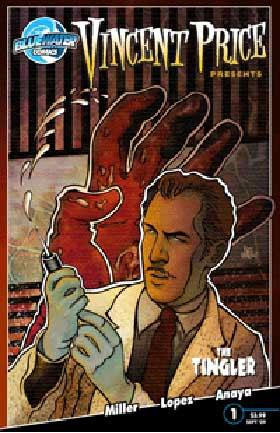
In stores today!
VINCENT PRICE PRESENTS: THE TINGLER #1-2
Writer: Mark Miller Artists: Alex Lopez and Anaya Published by: Bluewater Comics An @$$hole 2-in-1 review by Matt Adler and BottleImp
BottleImp (Imp): The William Castle horror movies of the 1950s always reminded me of their contemporaries on the comics stands, EC’s horror comics. Both the films and the four-color counterparts gave their audience jolts, shivers, screams, but also laughter, as neither Castle nor EC publisher Bill Gaines took their work too seriously. Their version of horror was more akin to a roller coaster ride at the state fair—good for a few thrills, scary when you’re on it, but ultimately harmless. So it’s nice to see that same spirit of fun in Bluewater’s comic book sequel to Castle’s famed gimmick-enhanced movie THE TINGLER.Matt Adler (Matt): I really wasn't familiar with any of the William Castle movies, beyond knowing that John Goodman's 1993 movie "Matinee" was a tribute to them, and made use of the "seat buzzer" gimmick. I was, of course, familiar with Vincent Price, but never really thought of him as an adventure hero until reading this. I wonder if Bluewater had to get permission to use his name and likeness?
Imp: I would hope that they got the permission from Price's estate. Bluewater's been doing the VINCENT PRICE PRESENTS comics for a little while now, so I would guess that they went through all the proper legal channels. Although grave-robbing Price's name would add a certain morbid twist to the series...
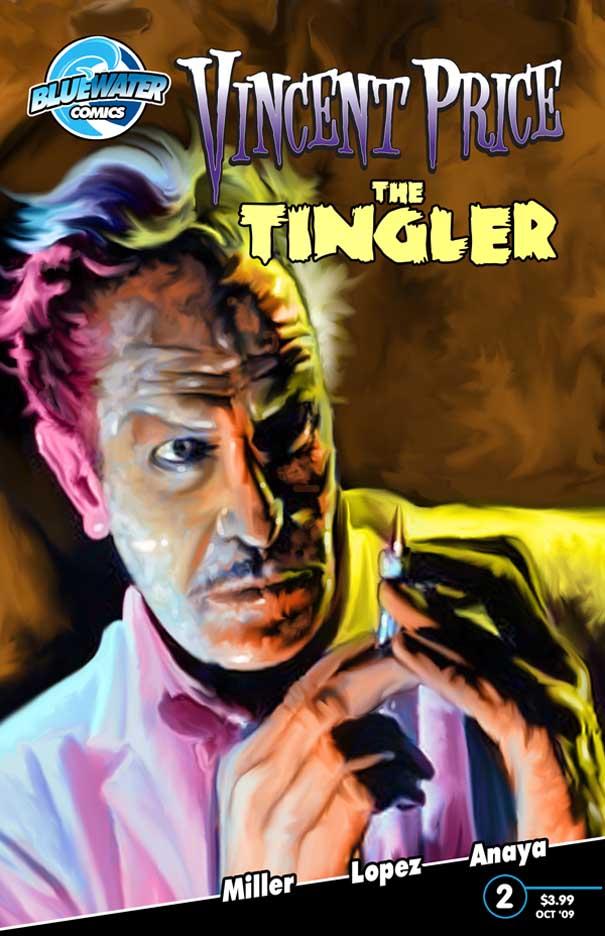 Anyways, back onto the comic at hand. As far as the writing is concerned, Miller has crafted a credible sequel to the original TINGLER story that really captures the tone and the energy of the 1950s horror flick. All the familiar archetypes are here: Vincent Price’s monomaniacal Dr. Warren Chapin, the scientist who dares to delve too far into the unknown; his sister-in-law Lucy, fulfilling the role of Damsel in Distress; the strong hero (Dave, Lucy’s husband and Warren’s assistant); and the slightly suspicious and unlikable hired man—who usually ends up dead before the third reel change. The plot of the comic makes a marked departure from the film by shifting the action to the African jungle, but this change in setting actually enhances that schlock-horror feel. It takes very little effort to imagine this story being acted out on the jungle stage on the backlot of Paramount, the set decorated with potted ferns and a poorly-painted backdrop of the night sky.
Anyways, back onto the comic at hand. As far as the writing is concerned, Miller has crafted a credible sequel to the original TINGLER story that really captures the tone and the energy of the 1950s horror flick. All the familiar archetypes are here: Vincent Price’s monomaniacal Dr. Warren Chapin, the scientist who dares to delve too far into the unknown; his sister-in-law Lucy, fulfilling the role of Damsel in Distress; the strong hero (Dave, Lucy’s husband and Warren’s assistant); and the slightly suspicious and unlikable hired man—who usually ends up dead before the third reel change. The plot of the comic makes a marked departure from the film by shifting the action to the African jungle, but this change in setting actually enhances that schlock-horror feel. It takes very little effort to imagine this story being acted out on the jungle stage on the backlot of Paramount, the set decorated with potted ferns and a poorly-painted backdrop of the night sky.Matt: I agree, Miller gets the 1950s tone down pat. I thought it might be difficult featuring a "lost African tribe", since, let's face it, in an actual 1950s movie they would be horrible stereotypes, but Miller deftly skirts that problem and makes them credible and frightening antagonists. As for Huxley, the hired guide, the good doctor is such a jerk to him, I began rooting for him to hit Chapin over the head with a shovel and leave him there.
Imp: I definitely got that vibe, too! But that again is a credit to Miller's faithfulness to the original material-- even when Price played the protagonist, he still gave off that sense of smug superiority. Watch the original HOUSE ON HAUNTED HILL (another classic Castle picture)-- there's another instance of Price as the thoroughly unlikable "hero." The only fault I found with Miller's story was that it ends rather abruptly. We have the group of explorers venturing into the unknown jungle, then the capture by the native tribe, then The End. I don’t know about you, but I couldn’t help feeling like this comic needed a third act.
Matt: That's so bizarre! Until you mentioned it, I didn't even realize that was it! I just naturally thought there had to be another issue coming. I agree with you, that is a rather abrupt conclusion. I guess perhaps it is meant to leave things to our imaginations, but after taking us on this journey with these characters, I'd like to have learned their fate (even if it wasn't a happy ending). Perhaps if the comic does well enough, they'll do a follow-up.
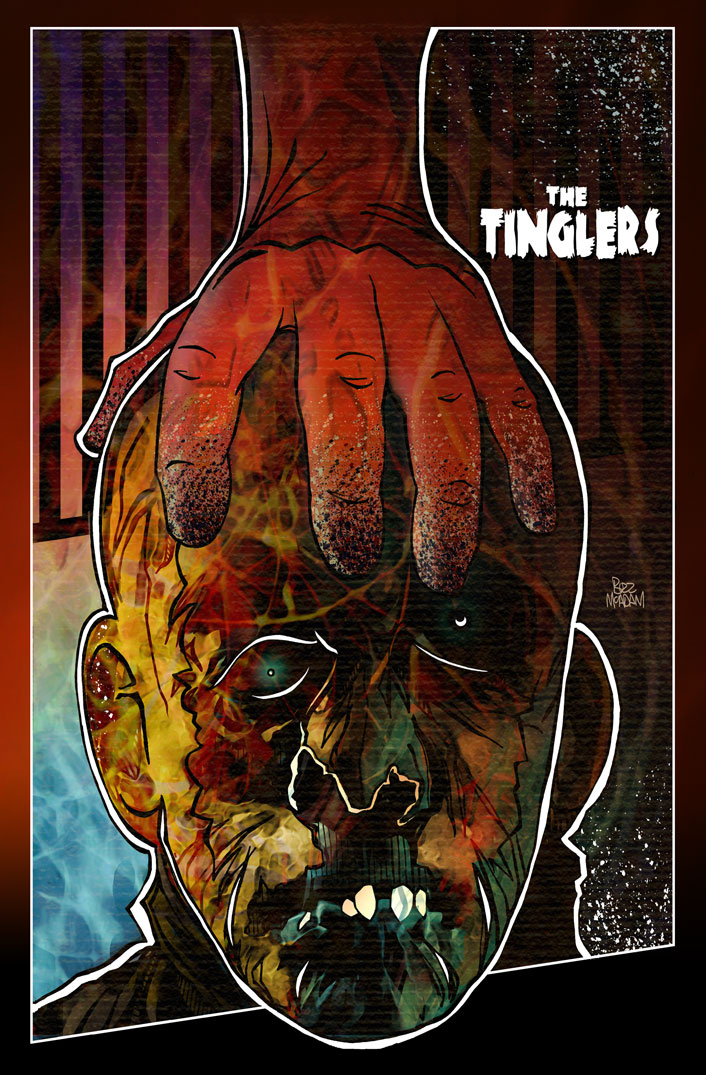 Imp: If Bluewater does decide to return to THE TINGLER and expand upon Miller's sequel, I would hope that they would find an artist whose work would be a better fit for the story. The visual aspect of this comic is lacking, in my opinion. For a plot centering around a creature that is the living embodiment of fear, there isn’t much fear to be found on the pages. Lopez’s drawing style just didn’t work for me, especially in combination with the color design—I found myself wishing that the art was either tighter and more realistic, which would have worked better with the carefully modeled color rendering, or that the cartoony style that Lopez’s art seemed to dance around was embraced more fully. A more stylized, less conventional manner of drawing might have brought this comic up to a different level. At the very least, it would have made each issue stand out better from the crowd.
Imp: If Bluewater does decide to return to THE TINGLER and expand upon Miller's sequel, I would hope that they would find an artist whose work would be a better fit for the story. The visual aspect of this comic is lacking, in my opinion. For a plot centering around a creature that is the living embodiment of fear, there isn’t much fear to be found on the pages. Lopez’s drawing style just didn’t work for me, especially in combination with the color design—I found myself wishing that the art was either tighter and more realistic, which would have worked better with the carefully modeled color rendering, or that the cartoony style that Lopez’s art seemed to dance around was embraced more fully. A more stylized, less conventional manner of drawing might have brought this comic up to a different level. At the very least, it would have made each issue stand out better from the crowd.Matt: It's a tough thing; Bluewater is a small publisher, so almost by definition, they're going to be hiring artists who are looking to hone their craft. I've certainly seen much worse efforts than Lopez's, so I can't be too hard on him, but of course I have seen more visually compelling horror comics. I'd love to have seen someone like Kyle Hotz on this book, but Bluewater isn't likely to be able afford him anytime soon. Overall, for a first professional effort, this isn't anything Lopez has to be ashamed of, and as he continues honing his craft, he'll eventually move up to the big leagues.
Imp: You're right, I'm just being super-critical, as usual. But in any case, I think we can agree that THE TINGLER is a fun throwback to the horror comics (and films) of yesteryear, right?
Matt: Indeed; it's an entertaining, engaging story with well-written characters, and if the worst we can say about it is that it leaves us wanting more, well, that's not too bad. Thumbs up.
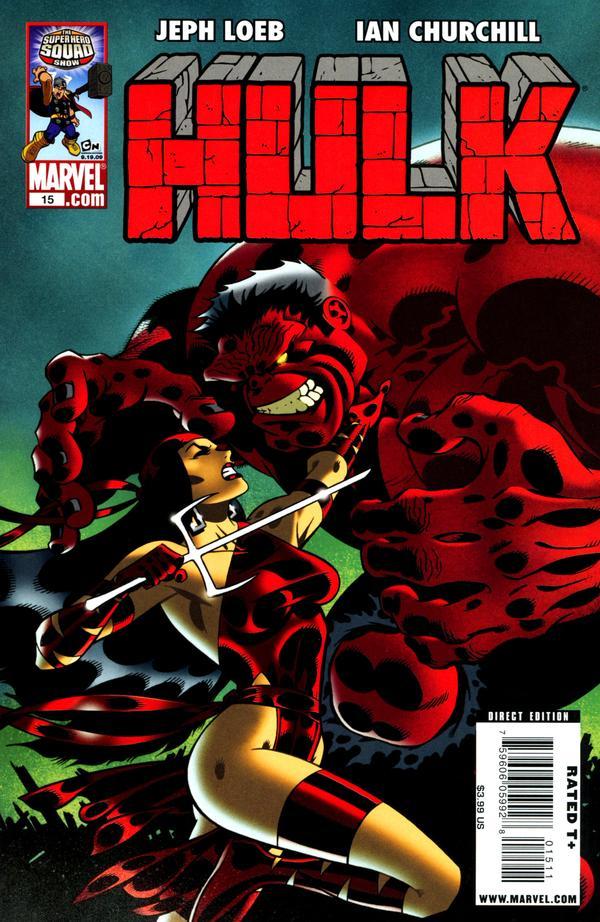
HULK #15: CODE RED
Writer: Jeph Loeb Art: Ian Churchill Publisher: Marvel Comics Reviewer: Mr. Pasty
I can’t believe it. Last week I went from Pasty to panegyrical over the direction Greg Pak has taken THE INCREDIBLE HULK and now, just one week later, Jeph Loeb has managed a similar transformation with HULK and its ill-gotten protagonist, the dreaded Red Hulk. Now in the past I’ve come down hard on Loeb for his mistreatment of this franchise, but I can only applaud him for what he’s accomplished in recent efforts and sincerely hope he continues down this path. How good is CODE RED? So good that the battle between Red Hulk and Wolverine is actually one of the book’s weaker moments.Red Hulk just seems like a different character altogether. Gone is the obnoxious blowhard who clomps around with all the grace and fluidity of an ED-209. In his place is an introspective and calculated aggressor, who carries the book with a Punisher-esque narrative that simultaneously outlines the internal conflict with the external. Maybe this personality development was by design? Regardless, it’s a welcome change and the comic book equivalent of going from Jedi to Empire instead of the other way around.
I mentioned Punisher and not coincidentally he makes a cameo here, as does a whole slew of heroes and villains, picking up where they left off in part one of CODE RED (ish 14). It’s almost a mini-civil war if you will and there’s a running gag between Deadpool and Warpath that’s laugh out loud funny. Anyone who’s worked in food service is likely to be amused. So Domino is on the run because she has the Red Hulk’s secret identity and a brouhaha breaks out between the aforementioned CODE RED (who must capture her) and X-Factor (who must save her). The result is pages upon pages of carnage but Loeb doesn’t abandon the story arc in favor of mayhem like he has in the past but instead progresses it. While the pacing was well handled, I almost felt distracted by the inevitable and disjointed showdown between Red Hulk and Wolverine.
I don’t think it’s unreasonable to suggest that THE INCREDIBLE HULK #340 was lightning in a bottle. Forget Hulk and Wolverine, this was Peter David and Todd McFarlane at their finest. Unfortunately the issue was so well done, there is little else to see between these characters that for my money, just don’t match up well as enemies. Not to mention that Wolverine has been rammed down our throats so hard that even Linda Lovelace is finding it hard to swallow. Still, Ian Churchill’s art is appropriately gratuitous and the Hulk/Wolverine feud is done with surprising restraint. It finds a place in the story without overshadowing it. Again, credit to Loeb for finally succumbing to the fact that no matter how cliché, the whole is greater than the sum of its parts.
In the end, that’s what makes CODE RED work so well. There are many different pieces to this puzzle but they finally start fitting together in an intelligent way that not only respects the reader, but the entire HULK franchise as well. It was worth the wait.
Final word: If the one dimensional Red Hulk of issues past left you searching for another book, give this series a second chance. Loeb has turned water into wine. An absolute must-have.
Web heads who can’t get enough of Mr. Pasty’s word vomit are encouraged to watch him operate as Nostradumbass over at here. MMAmania.com. Love, hate and Mafia Wars requests should be directed here.

BIRTH tpb NOVO Vol 1 THE BIRTH OF NOVO tpb NOVO Vol 2 THE PRIDE tpb
By Michael S. Bracco Publisher: Alterna Comics Reviewer: Ambush Bug
You never know when you're going to come across a good comic book. On a balmy Sunday afternoon in Chicago a few weeks back, I went to the Renegade Street festival. The fest is an alternative arts and crafts festival set in the Bucktown/Wicker Park/Ukranian Village area of Chicago. This year's fest had abundance of stands selling chotchkis and baubles and of course, trendy T-shirts. The crowd was filled with folks at various level of hipster. And of course, the canned PBR was overpriced. I wasn't going to this event to seek out comics. I had moved to the area recently, and after receiving a call from a pair of friends who were attending the fest, I decided to stop unpacking my millionth box of shit I probably will never use but can't throw away and meet up with them to make like a zombie in the noonday sun with the rest of what seemed to be a large portion of the hip and trendy of Chicago.Unlike my two friends who I met up with who were trying on dresses and jewelry, I wasn't really interested in stopping and checking out every stand. But while they stopped and checked out a particular crowded stand full of handbags or something over equal craptacularity, through the crowd of listless people, I saw an oasis. Comics! Well, not comics, a comic. Or three of them. As I approached I noticed that the writer/artist Michael S. Bracco was actually selling them at the fest. After telling him who I was, Bracco urged me to check out his books.
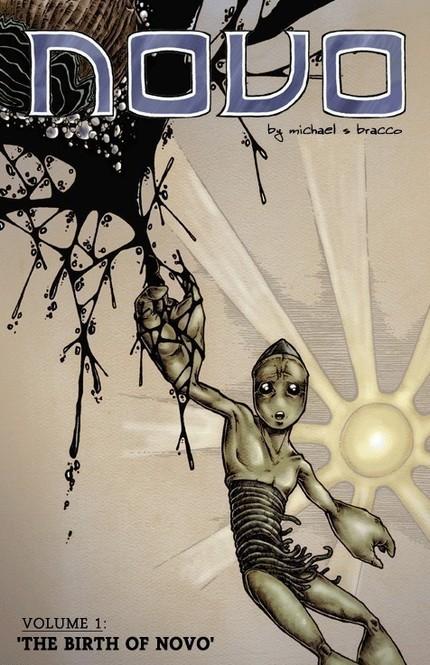 And I'm glad I did.
And I'm glad I did.The three trade paperbacks I picked up were BIRTH and its two sequels NOVO Vol. 1 and NOVO Vol. 2. I came to find out that Bracco is in the middle of an expansive story of epic scope. It's a book about the rise and fall of entire species of creatures on a desolate world who have all too human characteristics. The books depict the downfall of two races bent on destroying each other and a savior born just a bit too late to do any saving. This is also a book filled with gorgeous artwork depicting actions and images you've never seen before.
BIRTH, Bracco's first trade, introduces the reader to the Aquans and the Terrans, two warring races who blame each other for their eminent extinction. The story reads like a prelude, like the first fifteen minutes of exposition that occurs at the beginning of a large scale movie. If there's a criticism to be made about this book is that there's a lack of scene. Almost everything is told in caption or through action as nameless warriors clash and kill each other. This was a quick and exciting read, but I felt a bit of detachment to the story because there wasn't really anyone until late in the story to relate to. That said, the book does pack a powerful message and ends with a glimmer of hope. Once Bracco gives the reader some scenes of heft, he shows the reader that he's capable of doing so effectively. The story of BIRTH was necessary, but all in all breezy
. The story of BIRTH is made especially unimportant due to the fact that most of it is retold much more effectively in NOVO Vol. 1 as the child born at the end of BIRTH finds out about his warring ancestors and searches for purpose when he realizes that he is the messiah without any followers. The existence of Novo proves that the warring races had a future had they not killed each other. But with the races dead, this is a story of what happens to a shepherd without a flock. Novo's lonely quest across the barren planet is a fascinating exploration of loneliness and a search of purpose all can relate to.
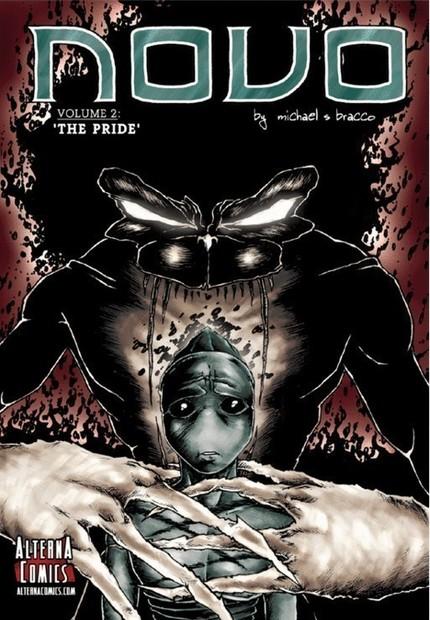 By the end of the first volume, Novo finds himself on a new track. Through a vision be has of his dead mother, Novo sets out to save other races of creatures that appear to be making the same mistakes his ancestors did. Throughout the first Volume and to a more evident extent in Volume Two, Novo is the voice of reason. He's that guy in the theater that screams "Oh come ON!" during an implausible moment of the film, pointing out how foolish the races are and how just a simple act of kindness and humility could save millions of lives. In the aptly named THE PRIDE, Novo travels to a planet filled with humanoid cats whose pride keeps sending out their pregnant females to an unsecure place to give birth. A murderous species of murky creatures kill the unprotected mothers and young while the population dwindles and the males stick to tradition rather than listen to the reason spouting Novo to just move the birth place to a safer place. Bracco handles a metaphor pretty well without beating one over the head with it. Novo in this story becomes a Christ-like character, sacrificing himself in order to prove a point, then being resurrected by his mother to go on another mission of species self-awareness
By the end of the first volume, Novo finds himself on a new track. Through a vision be has of his dead mother, Novo sets out to save other races of creatures that appear to be making the same mistakes his ancestors did. Throughout the first Volume and to a more evident extent in Volume Two, Novo is the voice of reason. He's that guy in the theater that screams "Oh come ON!" during an implausible moment of the film, pointing out how foolish the races are and how just a simple act of kindness and humility could save millions of lives. In the aptly named THE PRIDE, Novo travels to a planet filled with humanoid cats whose pride keeps sending out their pregnant females to an unsecure place to give birth. A murderous species of murky creatures kill the unprotected mothers and young while the population dwindles and the males stick to tradition rather than listen to the reason spouting Novo to just move the birth place to a safer place. Bracco handles a metaphor pretty well without beating one over the head with it. Novo in this story becomes a Christ-like character, sacrificing himself in order to prove a point, then being resurrected by his mother to go on another mission of species self-awareness. On top of the hefty themes and exciting storytelling, Bracco is a damn fine artist. His animal creatures aren't pieced together oddly; they look and move like they could actually exist. There's a lot of attention to biology and how a body works in these lithe figures and the hulking beasts. The sketchbooks at the end of each trade collection show that Bracco has a library full of imaginative beasties yet to come for Novo to meet
. While BIRTH may have had its problems with scene, it is undeniably an important chapter in this epic saga Bracco is mapping out. Once he gets to NOVO, though, the story really starts rolling. My suggestion is to read the two NOVO volumes first and if you're itching for more while we wait for the third, BIRTH serves as a capable filler until the next course. NOVO seems like a project more thought out than most indie concepts. It's high on action and sci fi, but it's the human core and all of the positives and negatives that that entails that makes this a story that leaps of the page and resonates on a much more meaningful level.
Ambush Bug is Mark L. Miller, reviewer and co-editor of AICN Comics for over eight years. Check out his short comic book fiction from Cream City Comics’ MUSCLES & FIGHTS VOL.3 and MUSCLES & FRIGHTS VOL.1 on his ComicSpace page. Bug was interviewed here and here at Cream City Comics. Look for more comics from Bug in 2009 from Bluewater Comics, including the sequel to THE TINGLER for their VINCENT PRICE PRESENTS ongoing series in stores September 2009 and VINCENT PRICE PRESENTS WITCHFINDER GENERAL and ROGER CORMAN PRESENTS DEATHSPORT to be released in late 2009/early 2010.
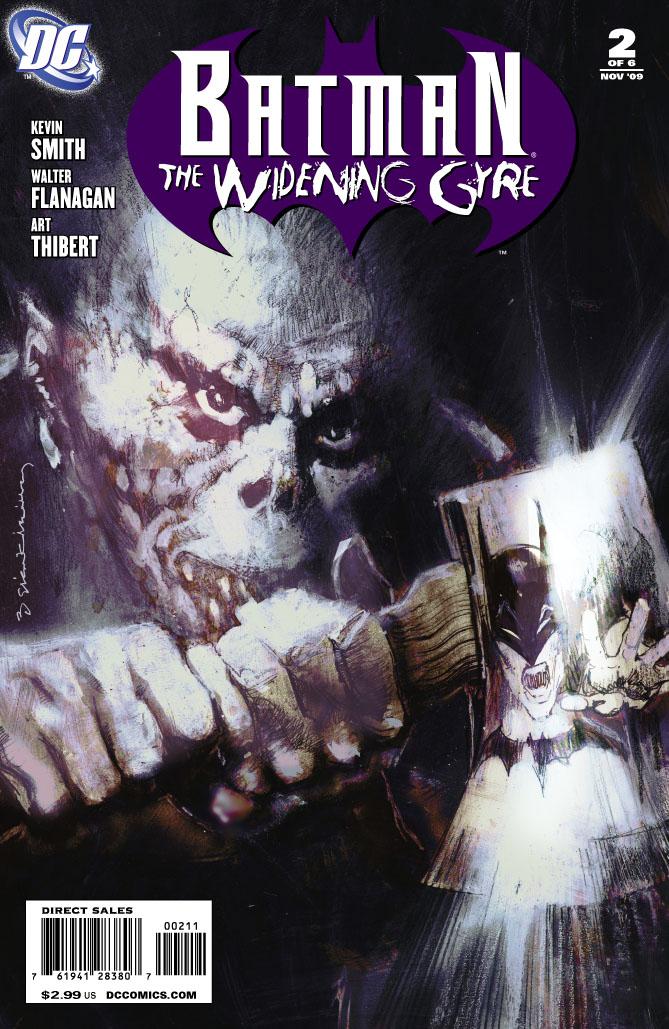
BATMAN: THE WIDENING GYRE #2 (of 6)
Writer: Kevin Smith Penciler: Walter Flanagan Inker: Art Thibert Published by: DCComics Reviewed by: BottleImp
What is it with DC going back to the 1970s? First there’s the whole Superboy and the Legion of Superheroes thing, and now Kevin Smith is bringing back Silver St. Cloud? Silver St. Cloud, who (correct me if I’m wrong) hasn’t been seen in DC continuity since the tail end of the Carter Administration? Oh, DC, when will your continuity be at last untangled… Anyhoo, Smith’s latest Batman mini-series hearkens back to those Steve Englehart/Marshall Rogers days with Bruce’s old flame returning to Gotham while The Batman tries to decide if the city’s newest vigilante (nicknamed “Goat Mask,” although the mask looks more like a Gazelle to me) can be trusted.I’ve got to give credit to Smith on this issue for expanding his writing beyond his usual repertoire of dick and fart jokes. Unlike the more-or-less straightforward action plot that he wrote in his previous Batman mini, CACAPHONY, Smith is actually giving the reader a story with layers and nuance. Granted, the theme that’s being kicked around here isn’t exactly innovative or unique, but it is a heck of a lot more interesting than CACAPHONY’s ultimate rehash of THE KILLING JOKE’s finale.
That theme is Batman’s desire for companionship—and no, I’m not talking about the ladies, even though both Bruce Wayne and his alter ego have had their share of “serious” relationships. Consider for a moment the size of Batman’s supporting cast. Now think about how many of these cast members are costumed crimefighters who are beholden to the details of Batman’s secrets. Correct me if I’m wrong, but I don’t think any other costumed character in DC’s roster—or even in the entire comics medium—has such a large “family” of fellow crimefighters. Heck, DC even published a great 64 page series in the early 1980s that bore the title, THE BATMAN FAMILY. Here’s what I think it comes down to: writers tend to focus on two aspects of the character of The Batman. The first is that he’s a tortured crusader for justice whose sense of duty is such that he can never put personal relationships above this purpose. The second is that having his family taken from him at such a young age has compelled Bruce Wayne to build a kind of surrogate family out of people whose circumstances mirror his own. The most interesting takes on Batman occur when a writer is able to take these two seemingly disparate aspects and make them both apply to the character.
That’s what Kevin Smith is handling so nicely in this series. His Batman reminisces about the days of working with a partner, even as in the flashback Robin realizes that his boss doesn’t fully trust anybody. In this issue’s cliffhanger, it’s not the illusory image of his recently-returned girlfriend that causes Batman to drop his guard against the cannibalistic Cornelius Stirk; rather it’s the reassuring sight of Gotham’s newest mystery crimefighter—showing that Batman’s desire for family is inextricably tied into his mission for justice. Like I said, it’s nice to see Smith thinking about thematic elements instead of just falling back on the old standbys of gay jokes and bathroom humor.
Another perk of this series is seeing that Walter Flanagan has grown to be a more competent artist since his work on CACAPHONY. The character postures and panel compositions feel more fluid and cohesive, and there’s not as much of the awkward anatomy that tended to pop up in the earlier work. Every so often there’s a little “off” moment—at the end of this issue Batman lifts Stirk off his feet with a punch to the stomach, but in the next panel on the next page the room is suddenly pitch-black and Stirk is nowhere in sight—but for the most part, the visuals work smoothly. I hope that DC will realize that Flanagan is good enough to warrant giving him scripts in the future that don’t have Kevin Smith’s name attached.
All in all, this mini-series is shaping up to be an improvement over Smith’s last Batman run, and looks to be a worthy addition to the Batman mythos.
When released from his Bottle, the Imp takes the form of Stephen Andrade, an artist/illustrator/pirate monkey painter from the Northeast. You can see some of his artwork athere. He’s given up comics more times than he can remember. But every time he thinks he's out, they pull him back in.
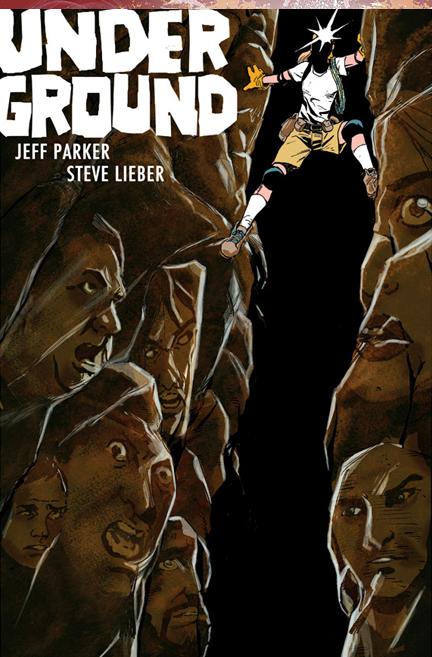
UNDERGROUND #1
Writer: Jeff Parker Artist: Steve Lieber Publisher: Image Comics Reviewed by Humphrey Lee
There’s nothing better for making one go from zero to OMG! than finding out two of your favorite creators have decided to team up and put out an item of their own creation. There’s just that little geek tingle you get, y’know? That little bit of anticipation that mounts from the potential you know that such a team up has between the two of them for a little bit of excellence. The problem though – especially from the reviewer front – comes from keeping yourself objective despite your excitement. Keeping your internal hype machine at a minimum is most likely not going to happen, but keeping it manageable so you don’t blow everything out of proportion before you even view panel one is where one needs to be. Like with all things – music, movies, video games, etc. – we need to remind ourselves that no matter how hopeful we are about a project it is best to not let yourself get so worked up over something that you are overrating it before it even comes out. Be excited, but keep that inner fanboy on a close leash, so to say…And with all that said, this book was really kind of neat.
The premise of UNDERGROUND is not one that one would find themselves unfamiliar with, though I will admit to not really having any examples of something similar in my brainspace right now. Basically, there’s a set of caves accessible right outside of a sleepy little Appalachian town that is being proposed for opening to the public. The town and the town’s biggest money man, Winston Barefoot, are in favor of this because of what it means towards the local economy. One Wesley Fischer, our heroine, (yes, there’s an ‘ine’ there despite the name) believes that it should be preserved and further explored, and obviously thinks there’s going to be some shenanigans about. Oh, and there be shenanigans, no doubt…
Now, what made this book, in all honesty, were the main two characters. Starting with a cute introductory moment where Wesley is in her bathroom trying to plan out what to say after having done a more fleshy sort of ‘spelunking’ with her friend/coworker Seth, Parker and Lieber immediately endear you with these two leads. Their conviction towards the caves and their jobs and each other are what really drive the book, and in a scant twenty-two pages Parker and Lieber make us care about what happens to them and interested in seeing where the current climate surround the town and caves will take them. At the very least, that alone makes a plot that is somewhat derivative worth watching play out one more time.
The other factor that makes this worth the price of admission is the wondrous penciling abilities of the Lieber half of this pairing I was so excited about. I’ll admit, I am huge, biased Steve Lieber mark because I have indeed met the man a couple times and on top of being one of the nicest creators I’ve had the pleasure of meeting, he also did a hell of a piece for me in my sketchbook. He also happens to be fucking talented as hell. The man is a master of the comics page who knows how to set a scene with eerie liveliness and has a range in his body types and facial expressions and so on on par with anyone I’ve seen in the business. So, yes, I am terribly biased in all things Lieber, but if he wasn’t so fucking good at what he did, I wouldn’t have solicited him for his craftsmanship in the first place.
So, sadly, despite my internal hype machine this book didn’t rock my perceptions of the comic book medium to its core. But, since I also like to think I am scarily rational about managing this Internal Fanboy Device, I just appreciated it for what it is, which is a character-driven piece of realistic action/adventure comic handled by two gentlemen that know the medium inside and out. Hopefully UNDERGROUND turns itself into something truly special by the end of its tale, but at the least I know I’ll be getting my money’s worth enjoying the ride each month, something that has become such a crapshoot these days in the industry. Thank god for creators you can trust to give it their best every time they come to the plate.
Humphrey Lee has been an avid comic book reader going on fifteen years now and a contributor to Ain't It Cool comics for quite a few as well. In fact, reading comics is about all he does in his free time and where all the money from his day job wages goes to - funding his comic book habit so he can talk about them to you, our loyal readers (lucky you). He's a bit of a social networking whore, so you can find him all over the Interwebs on sites like Twitter, The MySpaces, Facebookand a Blogger Account where he also mostly talks about comics with his free time because he hasn't the slightest semblance of a life. Sad but true, and he gladly encourages you to add, read, and comment as you will.
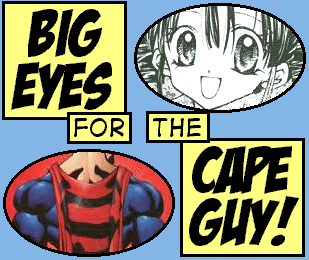
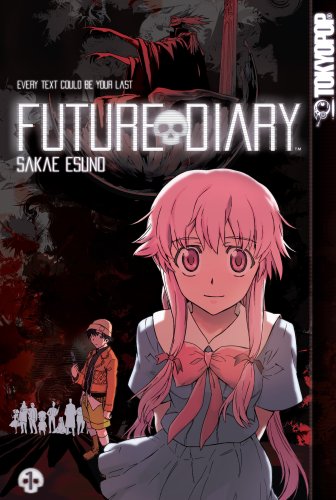
FUTURE DIARY Vol.1
By Sakae Esuno Released by TokyoPop Reviewer: Scott Green
FUTURE DIARY is serialized in SHONEN ACE, an anthology with more that its share of manga featuring characters with mental health problems – NEON GENESIS EVENGELION, GOTH, MPD PSYCHO, WELCOME TO THE NHK. In this case, the borderline, or outright pathological, personalities are entered into a last person standing death match. Comparisons to BATTLE ROYALE are unavoidable.Many of those comparable works weaves genre conventions and character dynamics into an engagement with social, psychological or metaphysical issues. I've almost always applauded manga for being thoughtfully relevant. FUTURE DIARY doesn't seem to take up that particular challenge, but one volume in, I'm not prepared to hold that or other potentially problematic issues against it.
Before reading FUTURE DIARY, I knew it featured a character type that I'm not particularly fond of.
To quote Patrick W. Galbraith's THE OTAKU ENCYCLOPEDIA: Yandere: "Yan" means mental or emotional illness, "dere" means to show affection. The term is used to describe a character whose good will toward their partner crosses the bounds of sanity and often comes to express itself in violent or brutal ways."
The most popular example of this is Higurashi - When They Cry, concerning a teenage boy who moves into a rural community, and quickly finds himself installed in a circle of friends with a group of local girls. To his dismay, he learns that their little competitions often feature sadistic "punishment games" for the loser, that Rena, a peer who dresses cute and obsesses over cute objects sometimes carries a large cleaver and seems to be searching the local dump for a body, and that the other girls have connections to acts of violence that are both recent and rooted in long running traditions. Higurashi eventually won over some of my respect. Its dealing with the dark side of the 80's economic boom and long standing relationships between rural and urban Japan had some sophistication. However, even after the causes were explained and the justifications were presented, it never fully scrubbed away my impression that those yandere characters were in some way based in or appealing to gynophobia.
Anime, and to a lesser extent, manga have been isolating themselves into an echo chamber of works created by hard core enthusiasts for hard core enthusiasts. This is the path that lead to TV schedules full of anemic moe and fixations with 2D girlfriends. Yandere appears to me to be a mutation of the hyper idealized girls that populate these works. The concept might be interesting if it were a critique of that guy-centric world view, but there is little to suggest that it is. The last thing that needs to be worked into a manner of thinking defined by a retreat into manufactured ideals is the notion that girls are Manchurian Candidates, whose interests are thin veneers for pathological obsessions.
That pink haired, pig tailed girl on the cover of FUTURE DIARY is series deuterogamist - Yuno Gasai. She's a good looking, successful student, who smiles innocently with that look that suggests that there aren't many gears turning in her head. In her introduction into the manga, she sits in class, playing with a piece of clay. Looks of childish concentration pass her face. When the bell rings and the class empties, the manga's hero, Yukiteru Amano walks over and sees that she has shaped an object that reveals that she knows his deepest secrets. Turns out she stalks him, loses her composure in a fit of weeping screaming and runs through a mine field to get to him, takes out another girl's eye... This is the poster child for yandere vibe in which girls are dangerous; a principle that is doubly true for girls who show affection.
Yet, FUTURE DIARY has a winsome craziness that causes me to give it a pass. The premise takes a collection of people who obsessively record things, generally based on some pathology; gives them a record ("diary" you might say) from the future, and forces them to kill each other. So, a driven police officer would have an "investigation" diary of future crimes. Someone always plotting out how to escape situations would have an "escape" diary drawing out escape routes. Yuno has a stalking diary of Yukiteru's actions.
Yukiteru is a notorious loner whose single activity is typing observations into his cell phone. As he explains "I just write down everything I see. Time, place, event... That kind of stuff.... It is completely random. My diary has no purpose." He goes to school. He goes home and day dreams. In his imagination he thinks up "Deus ex Machina, the King of Time and Space" - a sort of humanoid alien, scheming from a throne. Except, assuming that the manga isn't all a delusion, Deus ex Machina proves to be a real god. "If I am a real god, then I can live in your imagination or anywhere else for that matter." So, Yukiteru is given the first "future diary"... a cell phone with his diary containing entries from the future. Eleven other individuals, including Yuno are given their future diaries. If the phone/diary is broken, the owner's future is lost, and they are removed from existence. The diary owners are then given the tasks of eliminating each other, with the lone remnant supplanting Deus ex Machina in the office of god.
Sakae Esuno manages a nice trick here. The abilities of the diaries are evocative. Like the eponymous DEATH NOTE, they are rule based, instruments in a thriller that invites consideration. Layer on bits of branching bits Schrodinger's Cat and it feels like a smart conceit. And the same time, Esuno has clearly not been painted into a corner by over defining the rules of engagement. The markings of self-granted authorial freedom are all over this manga. So far, the Esuno has managed not to betray the reader with its unforeseeable twists. With its careening trajectory, the manga excuses itself from predictability or over organization.
Yukiteru and Yuno are cracked teens in normal guises and that normality is the handle that FUTURE DIARY offers for grasping its incendiary content. The other FUTURE DIARY possessors are immediate signals that the manga is not taking itself too seriously. There's a serial killer who's exceedingly overdone - towering Man with No Name look, with a face covered in motocross goggles/mask. Then, there's the manga's showcase of insanity piece - a terrorist bomber, dressed in a babydoll loligoth gown.
This is irrationality as an asset. Recently, I criticized Ikigami for opting for melodrama rather than a true consideration of the serious subject it was evoking. Conversely, Future Diary brings samurai action manga Rurouni Kenshin to mind. That manga dealt with the Meiji Restoration - the complex period marked by the overthrow of the shogun and Japan's modernization. In theory, it is a subject that calls for a nuanced approach. In Kenshin, it's texture and motivation for a familiar, if effective shonen fight manga. Lack of sophistication didn't stop Kenshin from being a memorable, popular manga, nor invalidate that success.
In theory, I'd like a manga that deals with mental health to be nuanced. I'd like a manga that took the time to lay out a set of operating rules for its conflict to strictly adhered to those rules. Future Diary offers enough of those qualities to resister claims at being sharp and intelligent without being laughed out of the conversation. Yet, it is a quick enough, energetic enough thriller that the implausibility and impracticalities lose traction in the forward rush.
Scott Green has been writing for AICN ANIME for over eight years. If you like what you see here and love anime & manga, be sure to check out his latest AICN ANIME column every week on AICN.

Another slew of indie goodies from your old pal Ambush Bug. be sure to click on the links to find out where you can pick up these damn fine reads from outside of the mainstream.
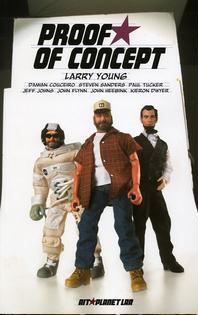
PROOF OF CONCEPT OGN AIT Planet/Lar
Larry Young is one creative guy. Although I've been in touch with Mr. Young through the years ever since I discovered his ASTRONAUTS IN TROUBLE stories and enjoyed them thoroughly, I only met him this year at SDCC. PROOF OF CONCEPT is the book he handed over to me and while it took me a while to get to it in my stack of swag, once I did I couldn't put it down. PROOF OF CONCEPT not only shows how many ideas Young has but also gives an entertaining, behind the scenes look at a pitch in mid-pitch. The story structure revolves around a phone conversation between Young and a superstar entertainment lawyer named Ken F. Levin (who I assume is an actual person given the way this story goes). Young pitches idea after idea with him and Levin either pans it or tells Young how cool it is and starts adding in his own suggestions. The comfortable tone and use of Hollywood language (taking into consideration distribution, spinoffs, what genre the story is best suited for, merchandise) makes this read authentic. Who knows if this is a compilation of many conversations Young has had with Levin or one long gab fest. Either way, I'd give a body part or two to be able to read some of the ideas Young and Levin lob back and forth. This book reminded me of conversations I've had with my creative friends, where someone comes up with an idea and it's tossed back and forth, being improved upon with each moment spent with it. Sure, this is a book full of cool ideas like the last vampire being hunted by a pair of over the hill vamp hunters or zombie dinosaurs or time police in search of their run amok in time ship captain or a hole in space found by a group of kids or a world populated by Lincoln clones or a woman who all of a sudden finds celebrity in becoming invisible. All of these stories are strong and well developed in the teases that are mapped out here by some talented artists such as Kieron Dwyer, Damian Couceiro, Steven Sanders, Paul Tucker, Jeff Johns, John Flynn, and John Heebink. But at its core this book is about that moment of inspiration and the joy of sharing it with others. Young captures this electric feeling perfectly and generously shares it with us. This is a book about ideas, yes, but it's also about the beauty and excitement about sharing them. It's a fine read and worth seeking out.